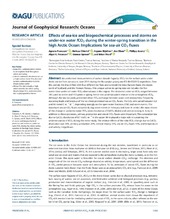| dc.contributor.author | Fransson, Agneta Ingrid | |
| dc.contributor.author | Chierici, Melissa | |
| dc.contributor.author | Skjelvan, Ingunn | |
| dc.contributor.author | Olsen, Are | |
| dc.contributor.author | Assmy, Philipp | |
| dc.contributor.author | Peterson, Algot Kristoffer | |
| dc.contributor.author | Spreen, Gunnar | |
| dc.contributor.author | Ward, Brian | |
| dc.date.accessioned | 2017-12-19T08:40:30Z | |
| dc.date.available | 2017-12-19T08:40:30Z | |
| dc.date.issued | 2017-07 | |
| dc.Published | Fransson AI, Chierici M, Skjelvan IS, Olsen A, Assmy P, Peterson AK, Spreen G, Ward B. Effects of sea-ice and biogeochemical processes and storms on under-ice water fCO2 during the winter-spring transition in the high Arctic Ocean: Implications for sea-air CO2 fluxes. Journal of Geophysical Research - Oceans. 2017;122(7):5566-5587 | eng |
| dc.identifier.issn | 2169-9291 | en_US |
| dc.identifier.issn | 2169-9275 | en_US |
| dc.identifier.uri | https://hdl.handle.net/1956/17028 | |
| dc.description.abstract | We performed measurements of carbon dioxide fugacity (fCO2) in the surface water under Arctic sea ice from January to June 2015 during the Norwegian young sea ICE (N-ICE2015) expedition. Over this period, the ship drifted with four different ice floes and covered the deep Nansen Basin, the slopes north of Svalbard, and the Yermak Plateau. This unique winter-to-spring data set includes the first winter-time under-ice water fCO2 observations in this region. The observed under-ice fCO2 ranged between 315 µatm in winter and 153 µatm in spring, hence was undersaturated relative to the atmospheric fCO2. Although the sea ice partly prevented direct CO2 exchange between ocean and atmosphere, frequently occurring leads and breakup of the ice sheet promoted sea-air CO2 fluxes. The CO2 sink varied between 0.3 and 86 mmol C m−2 d−1, depending strongly on the open-water fractions (OW) and storm events. The maximum sea-air CO2 fluxes occurred during storm events in February and June. In winter, the main drivers of the change in under-ice water fCO2 were dissolution of CaCO3 (ikaite) and vertical mixing. In June, in addition to these processes, primary production and sea-air CO2 fluxes were important. The cumulative loss due to CaCO3 dissolution of 0.7 mol C m−2 in the upper 10 m played a major role in sustaining the undersaturation of fCO2 during the entire study. The relative effects of the total fCO2 change due to CaCO3 dissolution was 38%, primary production 26%, vertical mixing 16%, sea-air CO2 fluxes 16%, and temperature and salinity insignificant. | en_US |
| dc.language.iso | eng | eng |
| dc.publisher | American Geophysical Union | en_US |
| dc.rights | Attribution CC BY-NC-ND | eng |
| dc.rights.uri | http://creativecommons.org/licenses/by-nc-nd/4.0/ | eng |
| dc.title | Effects of sea-ice and biogeochemical processes and storms on under-ice water fCO2 during the winter-spring transition in the high Arctic Ocean: Implications for sea-air CO2 fluxes | en_US |
| dc.type | Peer reviewed | |
| dc.type | Journal article | |
| dc.date.updated | 2017-12-05T14:26:53Z | |
| dc.description.version | publishedVersion | en_US |
| dc.rights.holder | Copyright 2017 The Author(s) | en_US |
| dc.identifier.doi | https://doi.org/10.1002/2016jc012478 | |
| dc.identifier.cristin | 1511924 | |
| dc.source.journal | Journal of Geophysical Research - Oceans | |
| dc.relation.project | Norges forskningsråd: 229786 | |
| dc.relation.project | Norges forskningsråd: 245927 | |
| dc.relation.project | Norges forskningsråd: 244646 | |

